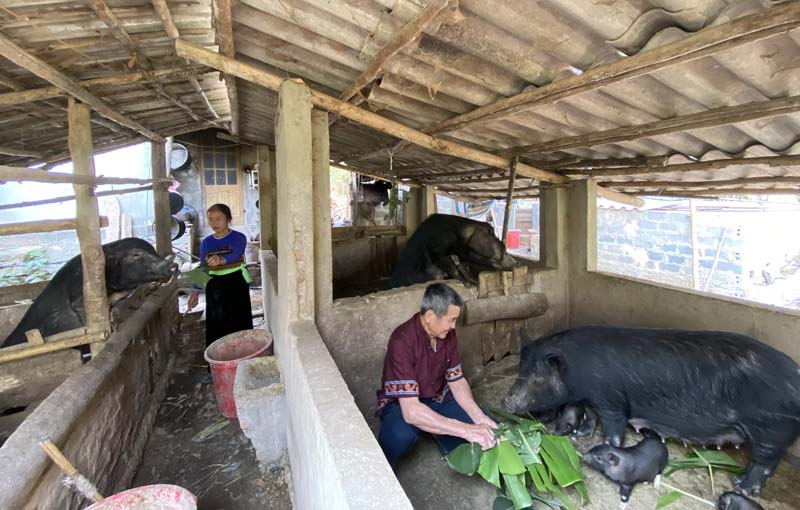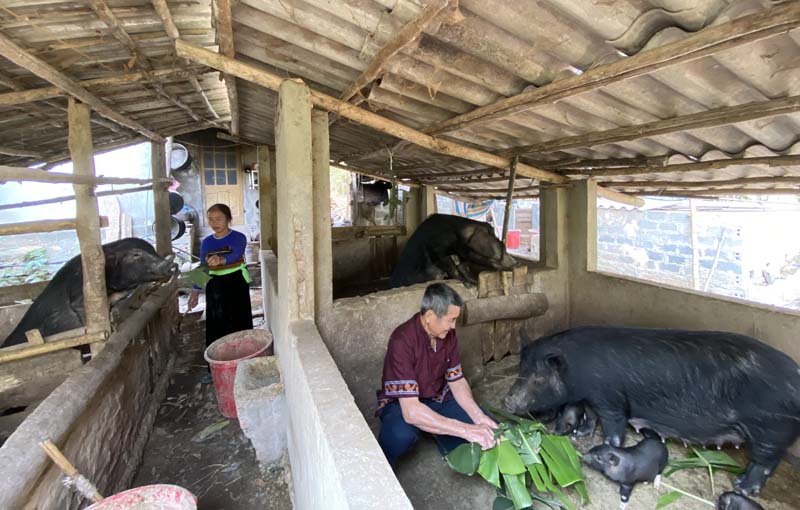
(HBO) - Despite raising black pig (an indigenous variety) for long, it’s only when joining the Muong Pa local pig breeding cooperative did member households in Xam Khoe and Bao La communes in Mai Chau district have chances to gain access to the commodity economy.
 Member households of Muong Pa indigenous pig breeding
cooperative in Xam Khoe commune (Mai Chau district) ensure a sufficient source
of piglets to reduce production costs and increase income.
Member households of Muong Pa indigenous pig breeding
cooperative in Xam Khoe commune (Mai Chau district) ensure a sufficient source
of piglets to reduce production costs and increase income.
Indigenous pigs are favoured by consumers thanks
to its delicious meat. To have high-quality products, the quality of piglets is
a decisive factor. Member households know that to participate in the commodity
economy, they have to take the initiative in the supply of piglets and feed.
Specifically, the supply of piglets is ensured by cooperative members by keeping
sows, while the main feed for pigs includes "rau duong” (Diplazium esculentum),
sweet potato, taro, colocasia gigantean and banana trunk, which are planted in
a large scale of thousands of square metres. Mash for pigs and veterinary medicine
are provided by the cooperative.
Member households are equipped with technical
guidance and knowhows to prevent diseases, therefore, the quality of pork is
ensured.
According to statistics, the cooperative is
raising a herd of 120-150 hogs and 20 sows. With active supply of piglets and
foodstuff and common breeding methods, member households can enjoy 65-70
percent in profits. In addition to connecting with a mash production company,
the cooperative has supported member households in seeking consumption markets.
Specially, through the help of the GNI in Vietnam, the cooperative has recently
put into operation a slaughterhouse which comprises of areas for breeding,
slaughter, semi-processing and waste treatment with a designed capacity of 20
hogs a day.
With the application of on-spot production,
semi-processing and food safety measures, Muong Pa cooperative eyes bigger and
more stable markets. The cooperative’s director said that it is striving to
have more members to develop further, thus contributing to helping indigenous pig
raising households access potential markets and gain stable livelihoods./.
Since the beginning of this year, under the direction of the Department of Agriculture and Environment, the Sub-Department of Agricultural, Forestry, and Fishery Product Quality Management has strengthened the integration of the professional activities to promote and guide the organizations and individuals in the production and trading of agricultural, forestry, and fishery products to comply with the legal regulations regarding the use of chemicals, pesticides and veterinary medicines in crop cultivation, livestock farming and aquaculture. They also provide guidance to processing and manufacturing establishments on keeping the records to trace the product origins and using food additives from the approved list according to the regulations.
Hoa Binh province saw a significant rise in state budget revenue in the first two months of 2025, heard a meeting chaired by Vice Chairman of the provincial People’s Committee Quach Tat Liem.
Ha Thi Ha Chi, a 26-year-old graduate in law, has taken an unconventional path by returning to her hometown in Mai Chau district to establish the Tong Dau Cooperative, creating stable jobs for local women and bringing Thai ethnic brocade weaving to the global market.
As the Lunar New Year 2025 approached, pork prices surged, creating a profitable season for farmers in Tan Vinh commune, Luong Son district. Taking advantage of the rising demand, Can Minh Son, a farmer from Coi hamlet, sold over 30 pigs at 69,000 VND/kg, each weighing more than 100 kg. After deducting expenses, his family earned a profit of over 50 million VND.
alternate member of the Central Party Committee, Secretary of the Hoa Binh provincial Party Committee Nguyen Phi Long on March 5 had a working session with Yan Jiehe, Founder and Chairman of the China Pacific Construction Group, one of China's largest private corporations in the field of transport infrastructure. Deputy Secretary of the provincial Party Committee, Chairman of the provincial People's Committee Bui Duc Hinh and leaders of provincial departments and sectors also attended the working session.
The electronic printed circuit board (PCB) manufacturing and processing plant of Japan’s Meiko Group, located at Da River Left Bank Industrial Park in Hoa Binh city with a total investment of over 200 million USD, is expected to create thousands of jobs and make a significant contribution to the local budget.



 Member households of Muong Pa indigenous pig breeding
cooperative in Xam Khoe commune (Mai Chau district) ensure a sufficient source
of piglets to reduce production costs and increase income.
Member households of Muong Pa indigenous pig breeding
cooperative in Xam Khoe commune (Mai Chau district) ensure a sufficient source
of piglets to reduce production costs and increase income.